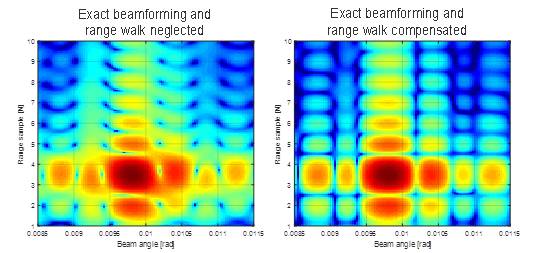Abstract's details
Fast and accurate Delay/Doppler processing: applying range walk compensation while preserving the computational complexity
Event: 2018 Ocean Surface Topography Science Team Meeting
Session: Instrument Processing: Measurement and Retracking
Presentation type: Oral
In Delay/Doppler (D/D) processing the range migration is usually approximated as a constant distance during a burst acquisition, under the assumption that within the antenna footprint the range walk can be neglected. Range walk is defined as the change in range distance among the pulses in one burst acquisition for a given Surface Sample (SS). This approximation allows for a great simplification of the processing, because the same range migration correction is applied for all the pulses in a burst, at the cost of a distortion of the 2D Impulse Response Function (IRF) when a target is seen at high look angle [1].
Recalling that the range walk compensation is different for each burst and for each SS and that the range walk needs to be compensated before beamforming, it can be applied only when exact beamforming is perfomed. In the exact beamforming algorithm, each of the Doppler beams is properly steered to be “exactly” pointed towards a SS. In the proposed D/D processing chain, a novel azimuth beamforming approach based on Discrete Fourier Transform was implemented in order to allow for the exact beamforming in conjunction with the rage walk compensation. This way the accuracy of the IRF is improved limiting the increase of the computational complexity with respect usual D/D processing.
The purpose of this abstract is to present both the theoretical basis for range walk compensation as well as the experimental results from in-orbit CryoSat acquisitions over transponder and over open ocean. By processing a CryoSat acquisition over the transponder, it was verified that the 2D IRF from a burst at high look angle is not distorted using the proposed processing chain, differently from what occurs when the range walk compensation is neglected. Additionally a dataset of CryoSat SAR acquisitions over ocean was processed using the proposed processing chain and then the geophysical parameters were retrieved using a semi-analytical retracker based on [2]. By analysis of this dataset it was verified that, applying the range walk correction, the SWH is about 5 cm lower up to SWH = 6m, while for higher values of SWH the bias is reduced. These results suggest that neglecting the range walk in Level1 processing is a contribution to the SWH bias between LRM and SAR.
[1] P. Guccione, "Beam Sharpening of Delay/Doppler Altimeter Data Through Chirp Zeta Transform," in IEEE Trans. on Geosc. and Rem. Sens., vol. 46, no. 9, pp. 2517-2526, Sept. 2008.
[2] L. Recchia, M. Scagliola, D. Giudici and M. Kuschnerus, "An Accurate Semianalytical Waveform Model for Mispointed SAR Interferometric Altimeters," in IEEE Geos. and Rem. Sens. Letters, vol. 14, no. 9, pp. 1537-1541, Sept. 2017.

Recalling that the range walk compensation is different for each burst and for each SS and that the range walk needs to be compensated before beamforming, it can be applied only when exact beamforming is perfomed. In the exact beamforming algorithm, each of the Doppler beams is properly steered to be “exactly” pointed towards a SS. In the proposed D/D processing chain, a novel azimuth beamforming approach based on Discrete Fourier Transform was implemented in order to allow for the exact beamforming in conjunction with the rage walk compensation. This way the accuracy of the IRF is improved limiting the increase of the computational complexity with respect usual D/D processing.
The purpose of this abstract is to present both the theoretical basis for range walk compensation as well as the experimental results from in-orbit CryoSat acquisitions over transponder and over open ocean. By processing a CryoSat acquisition over the transponder, it was verified that the 2D IRF from a burst at high look angle is not distorted using the proposed processing chain, differently from what occurs when the range walk compensation is neglected. Additionally a dataset of CryoSat SAR acquisitions over ocean was processed using the proposed processing chain and then the geophysical parameters were retrieved using a semi-analytical retracker based on [2]. By analysis of this dataset it was verified that, applying the range walk correction, the SWH is about 5 cm lower up to SWH = 6m, while for higher values of SWH the bias is reduced. These results suggest that neglecting the range walk in Level1 processing is a contribution to the SWH bias between LRM and SAR.
[1] P. Guccione, "Beam Sharpening of Delay/Doppler Altimeter Data Through Chirp Zeta Transform," in IEEE Trans. on Geosc. and Rem. Sens., vol. 46, no. 9, pp. 2517-2526, Sept. 2008.
[2] L. Recchia, M. Scagliola, D. Giudici and M. Kuschnerus, "An Accurate Semianalytical Waveform Model for Mispointed SAR Interferometric Altimeters," in IEEE Geos. and Rem. Sens. Letters, vol. 14, no. 9, pp. 1537-1541, Sept. 2017.

Contribution: IPC_02_Scagliola.pdf (pdf, 916 ko)
Back to the list of abstract